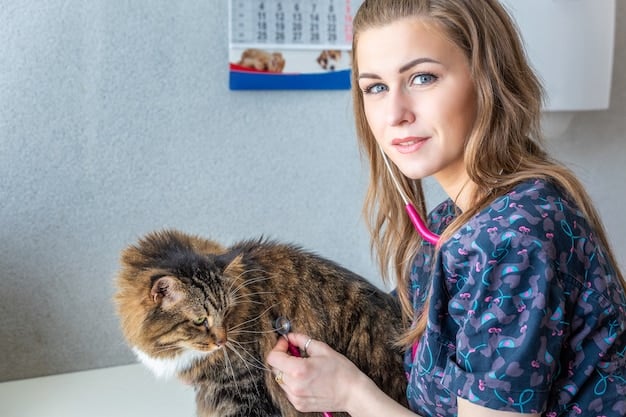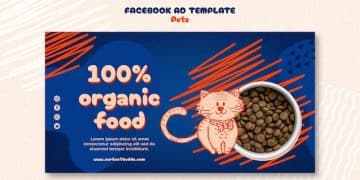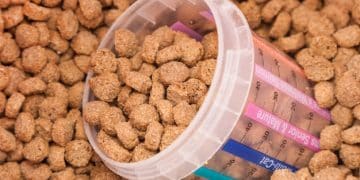Debunking Pet Health Myths: Separating Fact from Fiction

Anúncios
Debunking common pet health myths involves discerning fact from fiction to ensure pets receive optimal care, addressing misconceptions about diet, behavior, and preventative measures to promote their well-being.
It’s easy to fall prey to well-meaning but inaccurate advice when it comes to our beloved pets’ health. Debunking common pet health myths: Separating fact from fiction is crucial to ensuring they live their happiest, healthiest lives. This article will help you navigate the sea of misinformation and make informed decisions about your furry, scaly, or feathered friends.
Anúncios
Common Pet Health Myths Debunked
There’s a lot of information floating around regarding how best to care for your pets. Much of it, however, isn’t based on scientific evidence or veterinary expertise. Sorting through this information and identifying myths can significantly improve your pet’s health and longevity.
Myth: Table Scraps are Okay in Moderation
One common belief is that small amounts of table scraps are harmless for pets. While it might seem innocent, many human foods are toxic to animals, and even non-toxic foods can cause digestive upset or contribute to obesity.
Anúncios
- Chocolate: Contains theobromine, which is toxic to dogs and cats, causing vomiting, diarrhea, increased heart rate, and even death.
- Grapes and Raisins: Can cause kidney failure in dogs, the exact mechanism is still unknown.
- Onions and Garlic: Contain compounds that can damage red blood cells, leading to anemia, especially in cats.

Regularly feeding table scraps can also lead to weight gain and nutritional imbalances. It’s best to stick to a balanced pet food formulated for your pet’s specific needs.
In conclusion, while the occasional small, pet-safe treat might seem harmless, consistently feeding table scraps can be detrimental to your pet’s health. It’s always safer to stick to pet-specific food and treats.
Pet Food Fallacies: What You Need to Know
Choosing the right food for your pet can be overwhelming. Marketing tactics often create confusion and perpetuate myths about pet food ingredients and nutritional value. Understanding these fallacies can help you make informed choices.
Myth: Grain-Free is Always Better
Grain-free diets have become incredibly popular, with many pet owners believing they are inherently healthier. However, grains are not necessarily harmful and can provide valuable nutrients.
- Nutritional Value of Grains: Grains like rice, barley, and oats can be good sources of fiber, vitamins, and minerals.
- Grain Allergies: True grain allergies are relatively rare in pets. Often, sensitivities are to specific protein sources rather than grains themselves.
- Potential Risks of Grain-Free Diets: Some grain-free diets have been linked to heart problems in dogs due to the use of alternative carbohydrate sources.
Unless your veterinarian has diagnosed a specific grain allergy, there’s often no need to avoid grains altogether. Focus on a balanced diet that meets your pet’s individual needs, regardless of whether it contains grains.
In closing, grain-free diets are not automatically superior. Consult with your vet to determine the best diet for your pet, considering their specific health requirements and potential sensitivities.
Decoding Pet Behavior Myths
Understanding your pet’s behavior is essential for building a strong bond and addressing any underlying issues. However, many misconceptions about pet behavior can lead to misunderstandings and ineffective training techniques.
Myth: Dominance is Key to Training
The idea that pets, especially dogs, need to be dominated in order to be well-behaved is a long-standing myth. This outdated approach can be harmful and counterproductive.
- Positive Reinforcement: Modern, science-based training methods focus on positive reinforcement, rewarding desired behaviors with treats, praise, or toys.
- Understanding Motivation: Instead of trying to dominate your pet, focus on understanding their motivations and addressing the root causes of unwanted behaviors.
- Building Trust: Positive reinforcement builds trust and strengthens the bond between you and your pet, leading to better cooperation and fewer behavioral problems.
Using punishment or force can create fear and anxiety, damaging your relationship with your pet and potentially leading to aggression. Positive reinforcement is a more effective and humane approach.
In summary, dominance-based training is outdated and harmful. Positive reinforcement is a more effective and ethical way to train your pet, building a strong, trusting relationship.
The Truth About Pet Vaccinations
Vaccinations are a crucial part of preventative healthcare for pets. However, many myths surround vaccinations, leading some pet owners to question their safety and necessity. Understanding the facts can help you make informed decisions about your pet’s health.
Myth: Indoor Pets Don’t Need Vaccinations
One common misconception is that pets who live exclusively indoors don’t need vaccinations. While their exposure to certain diseases may be lower, they are still at risk.
- Disease Transmission: Some diseases can be transmitted through the air or brought into the home on clothing or shoes.
- Legal Requirements: Many areas require certain vaccinations, such as rabies, by law.
- Protecting Overall Health: Vaccinations protect your pet from serious and potentially fatal diseases, regardless of their lifestyle.

Consult with your veterinarian to determine the appropriate vaccination schedule for your pet, taking into account their age, lifestyle, and local disease prevalence.
In conclusion, even indoor pets benefit from vaccinations. They provide essential protection against potentially life-threatening diseases.
Dental Health Myths: Beyond the Bad Breath
Dental health is often overlooked in pets, but it’s a critical aspect of their overall well-being. Many myths about pet dental care can lead to neglect and serious health problems.
Myth: Bad Breath is Normal
While some pet owners dismiss bad breath as a normal part of pet ownership, it’s often a sign of underlying dental disease.
- Dental Disease Indicators: Persistent bad breath, excessive drooling, difficulty chewing, and red or swollen gums are all signs of dental problems.
- Systemic Health Impact: Untreated dental disease can lead to more serious health problems, including heart, liver, and kidney disease.
- Preventative Care: Regular dental cleanings, at-home brushing, and dental chews can help prevent dental disease and maintain your pet’s oral health.
Don’t ignore bad breath in your pet. Schedule a dental checkup with your veterinarian to assess their oral health and develop a preventative care plan.
In closing, bad breath is not normal in pets and can indicate underlying dental disease. Regular dental care is essential for maintaining their overall health and well-being.
The Impact of Flea and Tick Myths
Flea and tick control is essential for protecting pets from parasites and the diseases they transmit. However, many myths about flea and tick prevention can lead to ineffective treatment and health risks.
Myth: Indoor Pets Don’t Need Flea and Tick Prevention
Even pets that spend most of their time indoors are still at risk of flea and tick infestations. These parasites can hitch a ride on clothing, shoes, or other pets, making their way into your home.
- Year-Round Prevention: Fleas and ticks can be active year-round, even in colder climates.
- Disease Transmission: Fleas and ticks can transmit diseases like Lyme disease, ehrlichiosis, and tapeworms.
- Effective Products: Various flea and tick prevention products are available, including topical treatments, oral medications, and collars.
Talk to your veterinarian about the best flea and tick prevention products for your pet, taking into account their lifestyle, age, and health status.
In summary, even indoor pets require flea and tick prevention. Protecting your pet from these parasites is essential for their health and well-being.
| Key Point | Brief Description |
|---|---|
| 🍎 Table Scraps | Human foods can be toxic or lead to obesity; stick to pet-specific diets. |
| 🌾 Grain-Free Diets | Not always better; grains provide nutrients unless there’s a diagnosed allergy. |
| 🐾 Dominance Training | Outdated; positive reinforcement builds trust and is more effective. |
| 💉 Indoor Pet Vaccinations | Still necessary as diseases can be transmitted indoors. |
Frequently Asked Questions
▼
While bones can provide some dental benefits, they also pose risks such as choking, dental damage, and gastrointestinal obstruction. So it is better prevent than provide.
▼
Raw food diets can carry a high risk of bacterial contamination, posing health risks to both pets and humans. Consult your vet instead of providing risk diets.
▼
No, human shampoo has a different pH balance than dog shampoo and can irritate your dog’s skin. It can lead to itchiness and dryness for your pet.
▼
While cats have an impressive righting reflex, they don’t always land perfectly. The height of the falling cat affects this ability to land properly.
▼
Declawing is a surgical procedure that involves amputation of the cat’s toes and can cause chronic pain. This is a disadvisable method and is highly discouraged.
Conclusion
By debunking these common pet health myths, pet owners can make more informed decisions, ensuring their beloved companions lead healthier, happier lives. Remember to consult with your veterinarian for personalized advice tailored to your pet’s unique needs.






